The Ellerman Indian Passenger Liner with a Tragic Ending
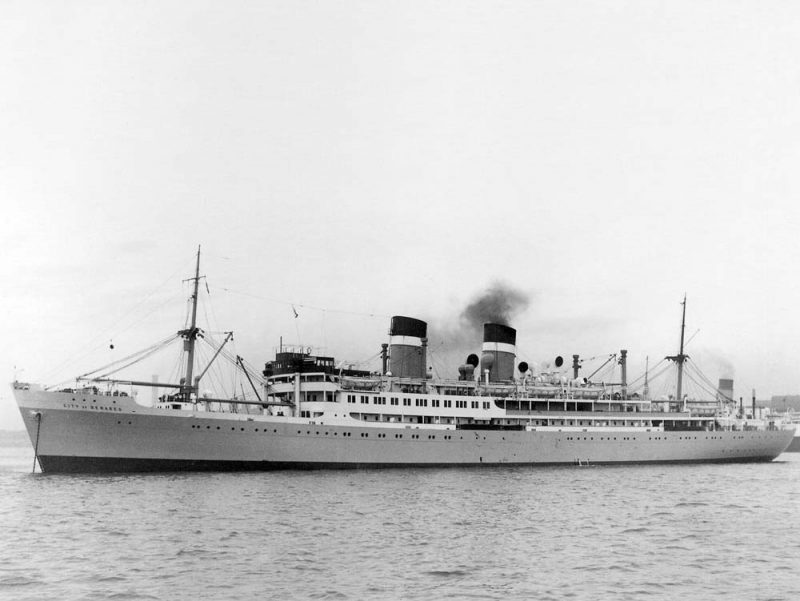
City of Benares of 1936 was the only twin funnelled passenger liner owned by Ellerman Line, and was acknowledged by most pundits as their most beautiful ship, and widely held to be among the loveliest of all twin funnelled passenger liners. She was designed for the Indian trade to Bombay of her owners with her aft funnel as a dummy, and had the accumulated experience of the Indian trade that began a century earlier with the City Line trading to the sub-continent since 1840. There were nine other passenger liners in the City Line fleet at this time, and a further pair in the Hall Line fleet trading to South Africa, all with accommodation for between one hundred and 350 passengers, usually in one class. These grey hulled ships were City of Baroda of 1918, City of Cairo of 1915, City of Canterbury of 1922, City of Exeter of 1914, City of Hongkong of 1924, City of London of 1907, City of Marseilles of 1913, the flush decked City of Nagpur of 1922, City of Paris of 1922, City of Simla of 1921, and City of Venice of 1924. The voyage to India took longer and was not as grand as those of P. & O., but this was compensated by a freer atmosphere, less class distinction, good food, and better open air promenading spaces. Ports of call were Marseille, Port Said and Bombay with occasional calls at Port Sudan, Colombo and Madras.
City of Benares was ordered from the Whiteinch yard of Barclay, Curle & Co. Ltd. on the Clyde, which had been controlled since 1912 by Swan, Hunter and Wigham Richardson Ltd. of Wallsend on Tyne, with joint design teams working on the many fine passenger liners built by both yards for many British and foreign liner companies, including Ellerman Lines. She was Yard number 656 and was launched on 5th August 1936 and named for the city of Benares in northern India, her funnels being added during the fitting out, and on her trials on 10th October she achieved a speed of 17.75 knots without unduly pressing the turbines. She was delivered to City Line on 15th October 1936 with a grey hull and white fo’castle, and left the Clyde for Liverpool the following day, and sailed on her maiden voyage from Liverpool to Bombay via Marseille, Suez and Karachi eight days later. The return voyage from Bombay to Liverpool began on 7th December 1936 with a full cargo of Indian produce, her deadweight tonnage being 9,756 tons.
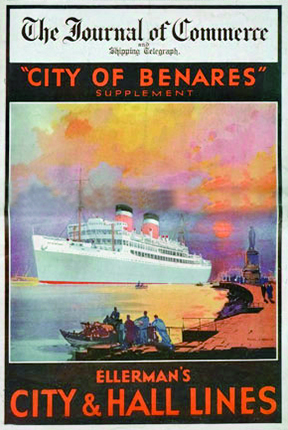
She was the fifth of this name in the City Line fleet, the first being a three masted sailing ship of 682 grt built by Barclay, Curle & Co. Ltd. in 1853 and destroyed by fire at the water’s edge at Calcutta on 31st January 1865.
The second was also a three masted sailing ship of 1,187 grt built by Barclay, Curle & Co. Ltd. in 1865 and was sold out of the fleet in 1891.
The third was also a large three masted sailing ship of 1,574 grt built by Barclay, Curle & Co. Ltd. in 1882. She put into Port Stanley in the Falklands on 17th September 1891 after a mutinous crew turned her back from Cape Horn with weather damage on an outward voyage, she was later sold to Russian owners in 1900.
The fourth City of Benares was a large black hulled steel screw passenger and cargo steamer of 6,732 grt built by Workman, Clark & Company of Belfast as the first addition to the City Line fleet after its association began with the Ellerman Group in 1901. She became a troopship for the British Expeditionary Force in 1914, and then sailed on voyages to America, India and the Far East until she was broken up by Hughes Bolckow at Blyth in February 1933.
Design and Specification of City of Benares (V)
City of Benares (V) was designed as a modern, spacious passenger liner with accommodation for 219 passengers in one class (First Class), her running fleet mates also being mostly one class vessels. The public rooms were to be designed as well furnished and tastefully decorated spaces with long, tall windows to ensure the maximum of light and air to the rooms. She had a gross tonnage of 11,081 on dimensions of length 509.0 feet, moulded beam of 62.7 feet, and depth to Upper Deck of 34.6 feet and to Shelter Deck of 43.3 feet, with a loaded draft of 28.4 feet. She had three complete decks in her hull, namely and working downwards Shelter Deck, Upper Deck and Main Deck. The Promenade Deck and Boat Deck were above these three decks in the superstructure. She had a fo’c’stle of length 41 feet, a cruiser stern, and carried fuel oil, water ballast, feed water, and fresh water with a total of 1,448 tonnes in her double bottom of length 411 feet. The final design was tank tested in the William Froude Laboratory tank, with her construction being under the direction of the company marine superintendent and naval architect, Mr. W. Hinchcliffe.
She had nine part cemented bulkheads with the collision bulkhead carried up to the Shelter deck and the others to the Upper Deck. Watertight doors in these could be operated at the door and from positions on the Upper Deck. The ten compartments were the fore peak, aft peak, six holds, the engine room and a deep tank abaft the engine room. She had six hatches served by ten ton capacity derricks on two masts, and seven and five ton capacity derricks on three pairs of posts, with a fifteen ton capacity derrick at number two hatchway. A crow’s nest was fitted on the foremast and an Orlop Deck was fitted in number one hold, and the bow was raked and well rounded. She was provided with ten lifeboats (two of thirty feet length, six of 26 feet, and two of 23 feet), all launched by the latest type of gravity davits together with a patent ‘skate’ system to ensure controlled and perfect lowering control. She was given two very tall funnels with slanting ‘cutaway’ tops, the forward funnel being a dummy, and the rear part of the funnels were lower than the forward part. A series of tall engine room ventilators was grouped around the aft funnel.
The forward dummy funnel contained the emergency generator and fuel tanks, and exhaust draught fans, with the uptake exhausts from the boilers all led to the aft funnel. Number three hatch was immediately in front of the forward funnel and was then trunked through four decks including the ‘tween deck. Number four hatch was abaft the second funnel and this hold and ‘tween deck was used for the coal bunkers when burning coal, and could be used for the carriage of general cargo when burning fuel oil, the disadvantage being again that it was trunked through four decks. There was a deep tank abaft the engine room, which was available for fuel oil, cargo vegetable oil, or general cargo.
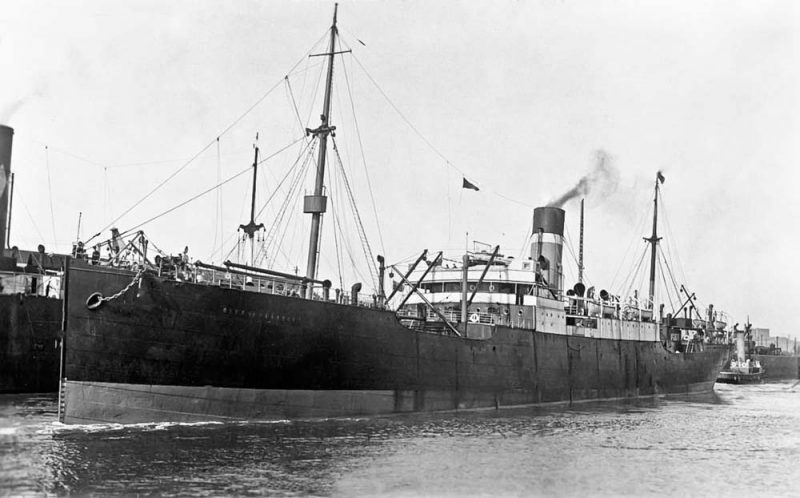
The Master and navigating officers were housed in good accommodation on Boat Deck below the navigating bridge, while the engineer officers had their cabins around the engine room casing and after funnel, with two side hatchways immediately aft of them and trunked down to the deep tank. The petty officers were berthed under the fo’c’stle on the Shelter Deck with the crew galleys aft. The Upper Deck had a number of staterooms forward, followed by the Dining Room, galleys and bakeries, then more cabins, and aft of number six hatchway the accommodation for the seamen and firemen. The Main Deck below contained mostly store rooms and cargo, with the accommodation for the stewards aft.
Public Rooms
The principal Public Rooms were the Dining Room on the Upper Deck, the Library and Writing Room on the Shelter Deck with the Children’s Playroom abaft passenger cabins, and the Main Lounge on the Promenade Deck with the Card Room, Cocktail Bar, both just aft of this Lounge, and a Verandah Cafe at the far aft of this deck. The decoration of the rooms was by the well known outfitting firm of Waring and Gillow of London, and descriptions of these rooms are as follows:-
The Dining Room accommodated two hundred people at a single sitting in a very spacious room set with tables for two, four, six and twelve passengers. It had a very modern treatment in two shades of English brown oak, relieved by a series of applied horizontal straps in cross banded Australian walnut. The stanchions and supports were cased in, and the panelled ceiling was painted in a pleasant shade of cream. The sidelights were enclosed within glazed bronze lattice work screens cleverly illuminated by concealed lighting. The lattice work effect was repeated in the bronze entrance doors at the forward end. The central main staircase at the after end led up to the deck above with bronze balustrades and sweeping steps to give a dignified entrance to this lovely room.
The Library and Writing Room were situated forward on Shelter Deck to take in the curve of the bridge front and extended practically to the full width of the ship. The room was panelled in Nigerian cherry, mahogany and holly woods, with these fine veneers giving an air of charm, quiet and comfort to the room. Arch headed bookcases enclosed within bronze glazed decorated doors flanked the recessed fireplace at the aft end of the room, and a radiator with a parabolic reflector was set against a background of black plate glass and silver beading to give off a warm glow from its bronze grill. The decking of the room was in close boarded oak covered with fine Indian carpets to harmonise with the covers of the comfortable sofas, carver chairs and easy chairs. The Children’s Playroom aft was painted in a colourful and interesting manner and featured nursery rhyme favourites.
Main Lounge on Promenade Deck. The oak panelled Entrance Hall on the Shelter Deck led up a staircase to the Promenade Deck, with the Main Lounge forward and then to the Card Room and Cocktail Bar, with a Verandah Cafe at the far aft end. The length of the Lounge and Card Room was well over one hundred feet, and they were very attractive and unique in conception. The walls were richly figured with white sycamore panelling and a relief of walnut beading. The rectangular supporting columns also used these two veneers, and the large, cosy window recesses were fitted with elegant French bay windows to give air to the room. The furniture of the Lounge was set out in attractive groups around the central dancing area, with parquetry panelled flooring of pleasing design and carpets and rugs of contrasting colours and patterns. The Promenade Deck was enclosed over the first half of its length, with tall Beclawat adjustable windows on the outer side, and covering the length of the Main Lounge, Card Room and Cocktail Bar, in order to give passengers shelter when entering or leaving these main rooms.
The Card Room and Cocktail Bar featured wide, folding white metal screens and recessed etched mirror clocks, with the cabinet for the tannoy system in the forward part of the room. The mirror clocks were electrically controlled from the master clock in the chart room behind the wheelhouse. The Card Room was on the port side, matched by the Cocktail Bar on the starboard side, with glazed metal screens between them in the centre of the ship. The Verandah Cafe opened out on the aft end of Promenade Deck on to the swimming pool with much cane furniture and painted walls and ceilings on three sides of the room. The swimming pool had underwater floodlighting for swimming in darkness, with wooden benches surrounding the pool, and could also be covered to form additional dance space on deck.
The Staterooms were strikingly decorated in individual colour schemes on the Upper Deck and Shelter Decks. There were twin berth and single berth Staterooms, with some arranged for converting into three berth rooms. White figured birch and finely grained oak furniture of a wardrobe, chest of drawers and a low set dressing table gave a stately feel to the rooms, with loose rugs covering the floor, and richly decorated headrests and coverings to the beds. All of the Staterooms had brass framed windows with reading lamps above the beds, and ornamental ceiling lights and others set at the side of the dressing table mirrors, together with electric fans for use in the tropics for the maximum comfort of passengers. Eight De Luxe staterooms on the Shelter Deck were richly decorated with modern panelling to show off the beautiful veneers used, as well as the covers of the easy chairs, sofas and fittings. The big benefit of a private en-suite bathroom was complemented by the same colour of cabin decoration used in the stateroom.
Engine Room, Electrical and Heating and Ventilation Installations
City of Benares was powered by three Parsons single reduction geared steam turbines of 6,600 shaft horse power giving a maximum speed of seventeen knots and a service speed of sixteen knots from a single propeller. Cammell Laird and Co. Ltd. of Birkenhead supplied the machinery, and the five single ended cylindrical boilers had a working pressure of 275 pounds per square inch and were fitted with superheaters to raise the final temperature of the steam by 180 degrees at the engine regulating valves. The boilers were originally designed to burn coal under a combined system of forced and induced draught with Howden air heaters, but provision was also made on the furnace front for burning fuel oil.


The turbine arrangement consisted of a high pressure turbine of the impulse reaction type, and intermediate and low pressure turbines of a full reaction type, each driving separate pinions and gearing. The high pressure turbine for astern working consisted of an impulse wheel incorporated with the intermediate ahead turbine, and the low pressure astern turbine of the impulse reaction type was fitted in the low pressure turbine casing. A regenerative type condenser was placed immediately below the low pressure turbine casing. The propeller was a four bladed manganese bronze type by J. Stone and Co. Ltd. of London and of 19.5 feet in diameter. The steering gear was of the steam hydraulic type by Hastie of Greenock, established in 1845. The anchor cables consisted of three hundred fathoms of 2.25 inch cable, and the Clarke Chapman windlass was steam driven.
The main electrical generating plant comprised three steam turbo sets, each of one hundred kilowatt output, housed in a large recess at the forward end of the machinery spaces, for the lighting of passenger staterooms, corridors and public rooms. The heating and ventilation system of the vessel was designed by Thermotank Ltd. of Glasgow. The system allowed individual passenger control of the volume, temperature and direction of air delivered to his or her stateroom. Punkah louvres were fitted in each stateroom, public room and officers’ and engineers’ cabins to control the warm air (in northern latitudes) or cold air (in tropical latitudes) supplied. The number of air changes provided throughout these cabins and rooms was very large so as to make the liner extremely comfortable during the variable climatic conditions encountered on an Indian voyage. A punkah louvre was fitted over each chair in the Dining Room, with the air being changed every ninety seconds. Adequate exhaust ventilation was also provided throughout all of the public rooms, kitchens, laundries, staterooms and bathrooms. Thermotank Ltd. supply fans and punkah louvres were also fitted in the very hot boiler and engine rooms.
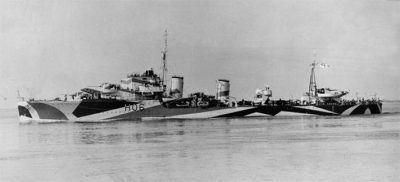
The kitchen, galleys and pantries were equipped with the latest equipment for rapid and efficient provision and service of meals. Large insulated store rooms were provided for domestic use, the temperatures in the various chambers being maintained by a Hall carbon dioxide refrigeration plant for all of the various foods, wines and spirits. A large cooled cabinet was provided in the bar and cocktail area on Promenade Deck. Fire detection systems with Rich smoke detectors were installed, with the fire indicating cabinet on the bridge giving the exact location and warning to the Officer of the Watch (OOW).
Tragic Final Evacuation Voyage
City of Benares underwent her last special survey and dry docking in November 1939. A voyage was fixed in September 1940 by the Ministry of Shipping from Liverpool to Montreal in ballast under the auspices of the Government sponsored Children’s Overseas Reception Board (CORB), set up in June 1940, to carry ninety children, aged from five years to fifteen, and ten escorting adults to the safety of Canada. The voyage was operated by Cunard White Star Line, with City of Benares specially chartered for the purpose. City of Benares embarked her passengers on 12th September at Prince’s floating landing stage in Liverpool. She was commanded by Capt. Landles Nicholl, aged 51 years, and she anchored in the midstream of the Mersey. Ten more children were also onboard, not part of the CORB scheme, but whose parents could afford to pay for a private berth and who had spent the previous night at the famous Adelphi Hotel in Liverpool. The CORB children were housed in the aft part of Main Deck, the lowest deck, and were kept entirely separate from the ten privately sponsored children, the two sets of children had no idea that there were other children onboard.
She sailed at 1800 hours on Friday 13th September, an inauspicious sailing date, in slow convoy OB213 with 406 people onboard, of which 209 were crew (43 European and 166 Asian), six convoy staff including Convoy Commodore Rear Admiral Edmond Julius Gordon MacKinnon DSO RN aged sixty years, and 191 passengers including the children. City of Benares was Convoy Commodore ship and thus placed at the head of the centre of three lines of ships. OB213 was a nineteen ship slow convoy of only eight knots, less than half the service speed of City of Benares, which conducted regular boat drills during the first four days of the voyage. The meagre escorts were one destroyer and two sloops, which left the convoy four days later at the extremity of their steaming range, around six hundred miles out into the Atlantic. The convoy thus entered the mid Atlantic ‘air gap’ completely unescorted and vulnerable to the many U-boat wolf packs operating there.
The wolf packs were waiting for the convoy, with U48 (Heinrich Bleichrodt) sinking three ships on 17th September, and firing two torpedoes at City of Benares at 2345 hours, both of which missed. City of Benares was clearly silhouetted by moonlight, and the U-boat moved into position again and fired one more torpedo at midnight, which struck home in number five hold aft on the port side, doing mortal damage to this fine liner in position 56° 48′ North, 21° 15′ West. The ship commenced to settle by the stern listing badly to port and ‘Abandon Ship’ was ordered. She managed to stay afloat for thirty minutes, with all lifeboats launched within fifteen minutes but several were swamped by waves. During this short time, every effort had been made to put the passengers into her lifeboats, but the seas were very rough and some boats capsized, drowning their occupants and adding to the fatalities already caused when the torpedo exploded underneath where some of the CORB children were housed aft on Main Deck. The searchlight of the U-boat swept over the chaotic scene as survivors struggled in the freezing water and then left the area for good. The Master, purser, chief officer, radio officer and three male passengers were still onboard when the vessel sank. They reached rafts but some died during the night along with many other survivors on upturned boats, rafts and wreckage. The Fourth Officer R.M. Cooper took his boat around the wreckage and picked up as many as possible and then set sail to the eastward.
The survivors in lifeboats had to endure a harrowing experience until rescue arrived the following day in the shape of ‘H’ class destroyer Hurricane commanded by Capt. Simms with Dr. Peter Collinson as Medical Officer. A ciphered signal was received just after midnight on 17th September in which the destroyer was ordered to proceed with ‘Utmost Despatch’ to the last position of the sunken liner. Capt. Simms surmised that this meant women and children were in the water, as a normal signal would say ‘Proceed Forthwith’. The first survivors were taken off a raft at 1400 hours on 18th September, two men and a boy named Jack Keeley aged six years. All of the survivors were suffering from severe exposure, varying degrees of shock, and were physically and emotionally exhausted. Many were dehydrated and most were suffering from bruised and sprained bodies, limbs and suspected fractures, as well as swollen legs due to prolonged exposure to sea water, the so called ‘Immersion Feet’. However, many small children had already succumbed to hypothermia in the bitter cold, including three small boys who could not be revived in spite of valiant attempts in the Petty Officers’ Mess at artificial resuscitation, and their bodies were later given a full naval burial by Capt. Simms.
The destroyer Hurricane rescued 105 survivors from rafts and lifeboats, of which a total of five died after being rescued, with the remaining one hundred landed at Greenock at midday on 20th September. A Sunderland flying boat sighted a further lifeboat, number 12, with the Fourth Officer R.M. Cooper and 45 survivors onboard on 25th September and radioed for assistance and dropped food parcels, with the destroyer Anthony reaching them at 1700 hours on the same day. She landed her 45 survivors including six children at Greenock on 26th September.
The death toll was 248 people, of which 77 were CORB children, 58 were adults, and 113 were crew members including the Master, Convoy Commodore, and three officers. Thus, only thirteen children survived out of ninety that had sailed under the CORB scheme, with six survivors of the ten privately booked children including the Bech family of mother Marguerite and three children (Sonia, Derek and Barbara). The total of children lost was thus 81 out of the one hundred that had sailed. The Indian Lascar crew lost 101 of their number of 160 onboard. Beryl Myatt, aged nine years, had travelled by train from Hillingdon near Uxbridge in West London to Liverpool as a CORB evacuee, however she was another child that was lost in this tragic sinking.
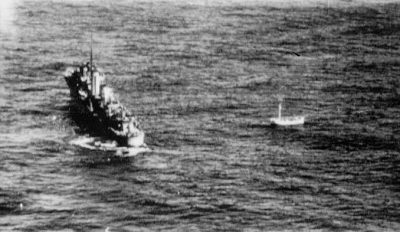
The CORB scheme was terminated immediately with all children and escorting adults taken off other liners preparing to sail. There had been little panic onboard during the harrowing evacuation of passengers, with much praise for the officers, including Fourth Officer R. M. Cooper, and their handling of the lifeboats full of calm and courageous children and their adult escorts. This evacuation of children by sea in City of Benares had a tragic outcome, with the surviving crew of U-boats saying in post-war years that they could never have known who the passengers were on sunken Allied liners, least of all that one hundred children were onboard City of Benares as she made her evacuation voyage to the supposed safety of Canada. The U.S. Secretary of State, Cordell Hull, described the action as a ‘Most dastardly act’, and it contributed in a small way to the U.S. entry into the war in December 1941. The CORB scheme in only three months of operation, had successfully sent 1,530 children to Canada, 577 to Australia, 353 to South Africa, and 202 to New Zealand, a total of 2,762 children that safely reached their destinations.
City of Benares was a memorable ship in her own right, but she is always remembered today for the tragic loss of young life on her last voyage. The benefit of hindsight gives me the feeling that it was a wrong decision to send City of Benares and the ninety CORB children and their adult escorts and other passengers in an eight knot convoy, when her speed of sixteen to seventeen knots allowed her to sail in the fast convoys operating from Liverpool across the Atlantic. However, the shortage of convoy escorts at this time would have meant a long wait for a fast convoy, and the evacuation scheme had already started. Nevertheless, City of Benares should have embarked her precious children and passengers as the scheme intended, and then waited for a fast convoy at Liverpool in my humble opinion. My opinion is reinforced by the fact that the liner Volendam of Holland America Line had been the first CORB scheme liner to be torpedoed with 325 CORB children onboard two weeks earlier on 30th August by U60, but all the children were fortunately rescued by nearby ships. Volendam survived and was towed in by Ranger of the Liverpool Salvage Association and beached on the Isle of Bute. She was out of commission for ten months until repairs were finished by Cammell Laird at Birkenhead. Care should have been taken after this torpedoing to place all CORB participating liners into fast convoys.
Elizabeth Cummings (nee Waldren) was one of the last survivors of City of Benares when she died on 12th August 2010. She was aged fifteen years when she boarded the ship with her ten year old brother Louis after travelling up by train from London under the CORB scheme. The CORB children were segregated with the boys on the port side and the girls on the starboard side aft on Main Deck, the lowest deck. When the torpedo struck, Elizabeth had to fight her way out of her cabin as a tall cupboard had fallen and blocked the door. She met up with her friend Beth Williams, aged fourteen years from Liverpool, and rushed up to the Boat Deck, but there was no sign of her brother Louis. They were directed to lifeboat five, which snagged during its descent and all of its occupants were thrown into the sea. Elizabeth and Beth and two dozen others swam back to the waterlogged boat and hung on for dear life until rescued the next day by the destroyer Hurricane. She was reunited with her brother Louis on the destroyer, but only three people survived from those thrown out of this lifeboat.
Postscript
A huge total of 58 Ellerman Lines vessels were lost during the war, more than half of the pre-war total of 105 ships, and this excluded two managed ships and the 25 losses of Ellerman’s Wilson Line. A big total of 153 Ellerman men were given awards for bravery and gallantry during the war. There were only four Ellerman passenger liners that survived the war, the City of Paris, City of Canterbury, City of Exeter and City of Hongkong. City of Exeter arrived at Dalmuir for breaking up on 14th July 1950, City of Paris made her last voyage from Lourenco Marques to Rotterdam, London, Hull and the Tees in 1955 and was broken up at Newport in February 1956, City of Canterbury was sold to Bisco on 1st June 1956, and City of Hongkong arrived at Savona for breaking up during the same month. The cost of newbuilding passenger liners was prohibitive in post-war years, and only the passenger route to South Africa was maintained after independence was granted to India in 1947 and the ending of the City Line passenger service to India. The independent countries of India and Pakistan set up their own merchant fleets, with the aim of carrying half of their trade in their own bottoms. In addition, there were not enough surviving Ellerman passenger liners to continue the Indian passenger service after 1947 as a profitable and well run operation.
Four of the most beautiful passenger and cargo-liners ever completed on the Tyne and at Barrow then came into service during 1952/53 as City of Exeter, City of York, City of Port Elizabeth and City of Durban with accommodation for 107 First Class passengers. They had a finely designed and balanced profile and large funnels to give a majestic appearance, especially with the sun shining on their handsome superstructures. They were the first motorships for Ellerman powered by twin six cylinder Doxford diesels to twin propellers to give service speeds of sixteen to seventeen knots. They carried the last part of their South African cargo in the bottom of their holds after discharge on the Thames up the East Coast to Middlesbrough and the Tyne. I well remember the quartet discharging lead and antimony ores over the side into barges at Newcastle Quay, with the barges towed downstream to Cookson’s Lead and Antimony Works for processing.
This handsome quartet were taken out of their South African service in 1971 and laid up and then sold to Greek owners for possible conversion into ferries, however only two of the quartet actually completed their conversions. Thus, passenger carrying on Ellerman ships ended at this point, with only one or two occasional passengers carried on the remaining cargo-liners, including Sir John Ellerman, son of the founder until his death on 17th July 1973, on his visits to his South African hotel in turbine powered vessels, diesels were too noisy. The final chapter of the great Ellerman shipping saga came to an end on 1st January 2005 when the Ellerman name was changed to Hamburg Sud, which had purchased the Ellerman Group in 2003. The sun thus set on a magnificent British shipping group that began when John Reeves Ellerman started his career in 1867, and then later took over in 1901 both City Line, formed in 1840, and Hall Line, founded in 1862 at Liverpool as the Sun Shipping Company with the first ships with a ‘Hall’ suffix to their names completed in 1868.
The name of the City of Benares will be remembered forever as the liner that was tragically sunk by a U-boat with such a horrendous loss of brave young life.

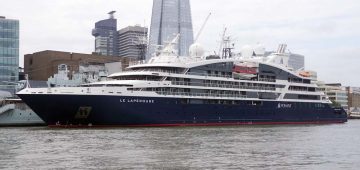



Comments
Sorry, comments are closed for this item